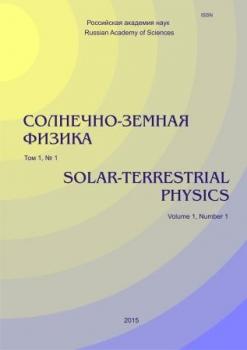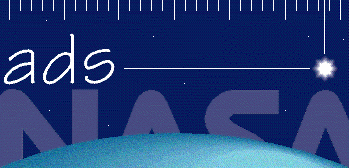St. Petersburg, Russian Federation
Russian Federation
St. Petersburg, Russian Federation
When observing the Sun with RATAN-600 radio telescope using a spectropolarimetric complex in the range 1–3 GHz, as well as when observing coronal rain, absorption in the radio emission was discovered in the spectral region 1.5–1.65 GHz in active solar regions located under a cold filament or on the limb under a prominence. The observed line structure corresponds to the hyperfine splitting frequencies in the ground state of X²Π₃/₂ hydroxyl (OH) 1612–1720 MHz. When the observed active region passes through the knife-shaped beam pattern of the telescope antenna, the absorption band shifts in frequency due to a shift in the energy levels of the OH molecule in a magnetic field, which changes along the filament.
Sun, coronal structures, absorption lines, hydroxyl
1. Bergemann M., Hoppe R., Semenova E., Carlsson M., Yakovleva S.A., Voronov Ya.V., et al. Solar oxygen abundance. Monthly Notices of the Royal Astronomical Society. 2021, vol. 508, iss. 2, pp. 2236–2253. DOI: 10.1093/ mnras/stab2160.
2. Derouich M. Inversion of Zeeman polarization for solar magnetic field diagnostics. New Astronomy. 2017, vol. 53, pp. 26–34. DOI:https://doi.org/10.1016/j.newast.2016.11.007.
3. Dravskih A.F., Dravskih Yu.A. Astronomicheskii Zhurnal. 2022, vol. 99, no. 6, pp. 496–50547. DOI:https://doi.org/10.31857/S000 4629922060032. (In Russian).
4. Gordon L.S., Rothman L.S., Hargreaves R.J., Hashemi R., Karlovets E.V., Skinner F.M., et al.. The HITRAN2020 molecular spectroscopic database. Journal of Quantitative Spectroscopy and Radiative Transfer. 2022, vol. 277, pp. 31–42. DOI:https://doi.org/10.1016/j.jqsrt.2021.107949.
5. Heyer M.H., Schloerb F.P. Application of principal component analysis to large-scale spectral line imaging studies of the interstellar medium. Astrophys. J. 1997, vol. 475, no. 1, rr. 173–187. DOI:https://doi.org/10.1086/303514.
6. Jaeggli S.A., Lin H., Uitenbroek H. On molecular hydrogen formation and the magnetohydrostatic equilibrium of sunspots. Astrophys. J. 2012, vol. 745, no. 2, article id. 133. 16 p. DOI:https://doi.org/10.1088/0004-637X/745/2/133.
7. Khersonskii V.K., Varshalovich D.A. The possibility of observing recombination lines in solar radiation. Astronomy Rep. 1980, vol. 24, no. 5-6, pp. 359–360.
8. Maeda K., Wall M.L., Carr L.D. Hyperfine structure of the hydroxyl free radical (OH) in electric and magnetic fields. New J. Phys. 2015, vol. 17, 045014. DOI:https://doi.org/10.1088/1367-2630/17/4/045014.
9. Ovchinnikova N.E., Lebedev M.K., Bogod V.M., Ripak A.M., Storozhenko A.A. Results of a new approach to the analysis of multi-wavelength observations data obtained with RATAN-600. Proc. The Multifaceted Universe: Theory and Observations. PoS(MUTO2022). 2022, p. 425.
10. Ovchinnikova N.E., Bogod V.M., Lebedev M.K. Detection of hydroxyl (OH) absorption line in the radio emission of the solar corona, in proceedings of XXVII National Annual Conference “Solar and Solar-Terrestrial Physics — 2023”. Saint Petersburg, 2023, p. 245.
11. Park H., Chae J., Song D., Maurya R.A., Yang H., Park Y.D., et al. Temperature of solar prominences obtained with the fast imaging solar spectrograph on the 1.6 m New Solar Telescope at the Big Bear Solar Observatory. Initial Results from the Fast Imaging Solar Spectrograph (FISS). Cham. 2013, pp. 105–116. DOI:https://doi.org/10.1007/978-3-319-12123-9_7.
12. Ripak A.M., Bogod V.M., Grenkov S.A. Lebedev M.K. RFI-Resistant Decimeter Band Radiometer for the RATAN-600 Radio Telescope. Astrophys. Bull. 2023, vol. 78, no. 4, pp. 622–634. DOI:https://doi.org/10.1134/S1990 341323600291.
13. Sanetaka Okada, Kiyoshi Ichimoto, Aki Machida, Satomi Tokuda,Yuwei Huang, Satoru Ueno. Temperature analysis of solar prominences by multi-wavelength observations. Publ. Astron. Soc. Japan. 2020, vol. 72, iss. 5, 71. DOI: 10.1093/ pasj/psaa014.
14. Smilde A.K., Bro R., Geladi P. Multi-way analysis: applications in the chemical sciences. John Wiley & Sons. 2005.
15. Wild J.P. The radio-frequency line spectrum of atomic hydrogen and its applications in astronomy. Astrophys. J. 1952, vol. 115, p. 206. DOI:https://doi.org/10.1086/145533.
16. Zirin H., Baumert B.M., Hurford G.J. The microwave brightness temperature spectrum of the quiet sun. Astrophys. J. 1991, vol. 370, pp. 779–783. DOI:https://doi.org/10.1086/169861.


















